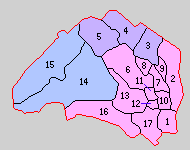AikŇć District, Kanagawa on:
[Wikipedia]
[Google]
[Amazon]
 is a district located in central Kanagawa Prefecture,
is a district located in central Kanagawa Prefecture,
 AikŇć District was one of the ancient subdivisions of Sagami Province, extending from central Sagami north to the border of
AikŇć District was one of the ancient subdivisions of Sagami Province, extending from central Sagami north to the border of
 is a district located in central Kanagawa Prefecture,
is a district located in central Kanagawa Prefecture, Japan
Japan ( ja, śó•śú¨, or , and formally , ''Nihonkoku'') is an island country in East Asia. It is situated in the northwest Pacific Ocean, and is bordered on the west by the Sea of Japan, while extending from the Sea of Okhotsk in the north ...
. It currently consists of only one town, Aikawa, and one village, Kiyokawa. The city of Atsugi was formerly part of AikŇć District.
Towns and villages
* Aikawa * KiyokawaHistory
 AikŇć District was one of the ancient subdivisions of Sagami Province, extending from central Sagami north to the border of
AikŇć District was one of the ancient subdivisions of Sagami Province, extending from central Sagami north to the border of Musashi Province
was a province of Japan, which today comprises Tokyo Metropolis, most of Saitama Prefecture and part of Kanagawa Prefecture. It was sometimes called . The province encompassed Kawasaki and Yokohama. Musashi bordered on Kai, KŇćzuke, Sagami, S ...
between the Sagami River and the Tanzawa Mountains. The district offices were located in what is now part of Atsugi. The area was part of a vast ''shŇćen
A was a field or manor in Japan. The Japanese term comes from the Tang dynasty Chinese term "ŤéäŚúí" (Mandarin: ''zhuńĀngyu√°n'', Cantonese: ''zong1 jyun4'').
ShŇćen, from about the 8th to the late 15th century, describes any of the private, ...
'' controlled by the ŇĆe clan, and their descendants, the MŇćri clan of ChŇćshŇę from the Heian period through the Sengoku period. It later became a contested area between the later HŇćjŇć clan of Odawara and the Takeda clan of Kai. In the Edo period, it was nominally part of Odawara Domain, although large portions were '' tenryŇć'' territory controlled by the '' shŇćgun'' in Edo
Edo ( ja, , , "bay-entrance" or "estuary"), also romanized as Jedo, Yedo or Yeddo, is the former name of Tokyo.
Edo, formerly a ''jŇćkamachi'' (castle town) centered on Edo Castle located in Musashi Province, became the ''de facto'' capital of ...
through various '' hatamoto''. From 1706, a branch of the ŇĆkubo clan
The were a ''samurai'' kin group which rose to prominence in the Sengoku period and the Edo periods.Meyer, Eva-Maria"Gouverneure von Ky√īto in der Edo-Zeit."Universit√§t T√ľbingen (in German) Under the Tokugawa shogunate, the ŇĆkubo, as heredita ...
in Odawara was permitted to establish the Ogino-Yamanaka Domain on a portion of the district. Other portions of the district came under control of Karasuyama Domain of ShimŇćsa Province.
With the Meiji Restoration of 1868, Ogino-Yamanaka Domain came under the control of Shizuoka Domain, while remaining territories became part of the new Kanagawa Prefecture. With the abolition of the han system in 1871, former Ogino-Yamanaka Domain became Ogino-Yamanaka Prefecture, and subsequently part of the short-lived Ashigaru Prefecture. It merged with Kanagawa Prefecture in 1876.
Timeline
* The new AikŇć and Tsukui Districts were established in 1878. * In 1889, AikŇć District was administratively divided into the following municipalities: ** one town (Atsugi) ** 16 villages (Koayu, Tamagawa, Nanmori, Mita, Tanasawa, Shimokawairi, Tsumada, Oikawa, Hayashi, Echi, Ogino, Aikawa, Takamine, Nakatsu, Susugaya and Miyagase) * In 1940, Aikawa Village was elevated to town status. * In 1946, Mutsuai Village was created through the merger of six villages (Mita, Tanasawa, Shimokawairi, Tsumada, Oikawa and Hayashi). * In 1955: ** January 15 ‚Äď The village of Takamine was absorbed into Aikawa. ** February 1 ‚Äď The village of Mutsuai merged with the town of Atsugi and three other villages (Koayu, Tamagawa and Nanmori) to form the city of Atsugi. ** July 8 ‚Äď The village of Echi was absorbed into Atsugi. * In 1956: ** September 30 ‚Äď Kiyokawa Village was created through the merger of two villages (Susugaya and Miyagase). ** September 30 ‚Äď The village of Nakatsu was absorbed into Aikawa. ** September 30 ‚Äď The village of Ogino was absorbed into Atsugi.Merger table
Districts in Kanagawa Prefecture {{Kanagawa-geo-stub